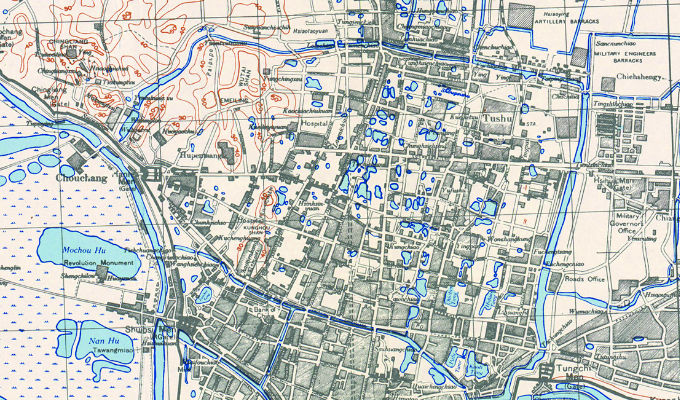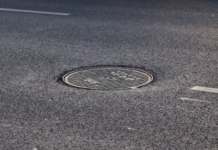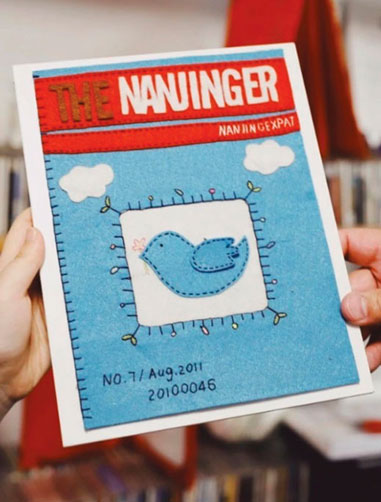Nanjing may be described as a mild and inclusive city, where local people are known for their calm nature. But still waters run deep for this city, where chasms divide the people of Nanjing’s various districts, who have over time become simply unacceptable to each other. With raging heart, they are united by but one belief; that where they live will always be best.
Nanjing’s 11 districts comprise (fearful of reprisal, we list them alphabetically) Gaochun, Gulou, Jiangning, Jianye, Lishui, Liuhe, Pukou, Qinhuai, Qixia, Xuanwu and Yuhuatai, each unique with their own special character and charm. If only it were that simple…
Gulou District
Gulou means “drum tower”, the traditional heart of a Chinese city, often the highest central location where a tower would be built, housing a drum to send messages quickly to the populace. Hence, in the eyes of the people of Gulou District, they are the very centre of the universe. In addition to its excellent location, Gulou is also home to the cultural and administrative centres of Jiangsu Province. In terms of education, Gulou District ranks second to none.
Such is their snobbery, the people of Gulou regard those from Xuanwu, Qinhuai, Jianye and Jiangning as basically their younger brothers. While some of the other districts have little sense of existence for Gulou people, they reserve special scorn for Lishui, which is “only good for strawberries” and Gaochun, as “the other side of the galaxy”.
Xuanwu District
Most of Nanjing’s tourist attractions are in Xuanwu. Visitors exiting Nanjing Railway Station first see the beautiful Xuanwu Lake, needless to say an excellent recommendation. Then there are the Sun Yat-sen Mausoleum, Ming Palace, Presidential Palace and Jiming Temple, to name but a few. The remains of the ancient capitals of the Six Dynasties are in Xuanwu. As a result, Xuanwu District sees a spike in GDP as soon as the holiday season hits. For Xuanwu people, they are the face of Nanjing.
For Xuanwu people, few other districts are worthy of consideration. Special disdain, however, is reserved for Qixia District next door as basically their back garden, Qinhuai that is simply full of the “disgustingly rich”, Jianye that is “way too young”, Yuhuatai which is merely “full of nothing but programmers” and Jiangning people who obviously have no impression whatsoever of quality.
Qinhuai District
Do you know where the real Nanjing is? It is of course the south of Nanjing, origin of the ancient capital of Jinling. It is here where the culture of Nanjing originated, with its beautiful views, including the Qinhuai River, Confucius Temple and, today, Xinjiekou. Somewhat amusingly, Qinhuai people regard Nanjing’s CBD as, “the #1 commercial district in China”, implying that they are not only not a widely travelled bunch, but also blissfully unaware as to the extent of their country’s borders.
Look at other districts. Admittedly, the scenery in Xuanwu is good, but Gulou is just full of a lot of schools. Yes, Jianye has developed well in recent years, but in Qixia, the traffic is rough, while there are way too many people in Pukou. As for Jiangning, nothing real estate; Liuhe, only good for pig head meat; Gaochun, same but for crabs.
Jianye District
Jianye is the future of Nanjing! In less than ten years, it has transformed from a virtually untouched fishing village into Nanjing’s hottest location, with modern electric trams, high-rise buildings, and companies such as Alibaba and Xiaomi settled therein.
As such, the modern Jianyeite believes next-door Gulou to be very old-fashioned, that unlicensed taxis are everywhere in Pukou, Qixia is dirty and messy, while fluorescent green taxis are Jiangning’s only hallmark. Finally, Liuhe, Lishui and Gaochun provide Jianye people with nothing but an impression of remoteness.
Yuhuatai District
Yuhuatai District is the first software industry base in Nanjing, home to well-known enterprises such as Huawei, Zhongxing, Neusoft, Runhe, Zhongdian etc. Therefore, local people are proud to say Yuhuatai is worthy of the title, “Nanjing Silicon Valley”, while also comparing nearby Yuhua E-park and Chuqiao City with the famous Xinjiekou and Aqua City downtown.
Somewhat inevitably, given the aforementioned history, Yuhuatai people believe next-door Jianye to be little more than a riverbank. The Dongshan Goose is likely sole highlight of Jiangning, Xuanwu might as well be called Traffic Congestion District, and as for Gaochun, well, you might as well just leave Jiangsu province altogether.
Qixia District
Nothing makes Qixia people more proud than their educational facilities. Colleges and universities in other districts are incomparable to Xianlin University City. Then there is also the scenery of Qixia, the red maple of Qixia Shan, Mufu Shan and the ebb and flow of Yanziji, all of which are famous among Nanjing people and great spots for visiting.
Moreover, compared with the old city, Qixia is less crowded while the air here is fresher. Housing prices are the cheapest in Nanjing; compared with other districts, it is likely easiest to settle in Qixia.
Jiangning District
In the eyes of Jiangning people, Jiangning’s strength is absolutely not to be underestimated; step by step, the counter-attack from a previously small county has become the most successful development centre in Nanjing. Or so they say…
Yet it remains true that Nanjing Lukou International Airport has its home in Jiangning, and it is without doubt that the district gives a very favourable impression of Nanjing to those arriving by air, together with the beautiful green sceneries of Niushou Shan, Fang Shan and Jiangjun Shan. Jiangning is also Nanjing’s largest district, while the Baijia Lake business district is regarded, by locals at least, as “half Xinjiekou”.
Gaochun District
As the southern gate of Nanjing, Gaochun is also home to China’s first Cittaslow, the international network of cities where living is good. Although they are aware economic development lags behind other districts, Gaochun people are proud of the words used to describe their beautiful and pleasant scenery, together with the yellow rape seed flower that blossoms everywhere during springtime. Folklore also abounds in Gaochun Old Street, Qiqiao Ancient Village, Gucheng Lake, all of which have a long ancient histories.
Lishui District
Lishui is now called the “Nanjing Back Garden”. In just a few years, the development of Lishui is amazing, with heavyweight projects one by one each year. While Lishui people think of themselves as “the immortals in the mountains”, to others, people will unconsciously think of strawberries and plum blossom, together with places such as Wuxiangshan, Fujiabian and Zhouyuan, that make for great spring and autumn outings.
Liuhe District
Liuhe is the northern gate of Nanjing and the hometown of the famed Yuhua Stone. It is true that Liuhe people feel forgotten, but they don’t care. For them, it is their cuisine that belongs in pride of place, delicacies such as pig’s head meat, lether belly and “活珠子”, an incubated chicken embryo. Vulgar to some, in the hands of Liuhe people, such are immediately reborn with unique flavour.
Pukou District
Home to Nanjing’s second national park, Lao Shan, Pukou was previously a traditional district well known for beautiful scenic spots. Yet, after the establishment of Jiangbei New Area in 2015, Pukou’s development now keeps pace with rockets. Partially as a result, traffic is abysmal and the metro over crowded. As a result, Pukou people believe they are not now who they were, but they appreciate their high levels of happiness. After all, house prices in Pukou without doubt offer the best price/performance ratio in Nanjing.














